
St. Paul's Episcopal Church is an historic Episcopal church in Richmond, Virginia, United States. Located directly across Ninth Street from the Virginia State Capitol, it has long been a popular house of worship for Richmond political figures, including General Robert E. Lee, Confederate President Jefferson Davis, and many Virginia governors throughout the years..
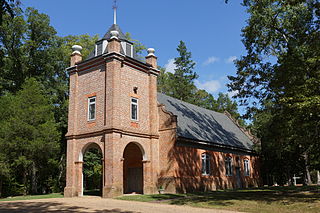
St. Peter's Church is a historic Episcopal church near Talleysville, Virginia, United States. Built in 1703, the church was designated as "The First Church of the First First-Lady" by the Virginia General Assembly in 1960 and added to the National Register of Historic Places in 1969. It was designated a National Historic Landmark on March 2, 2012, as an exceptionally well-preserved colonial-era church.
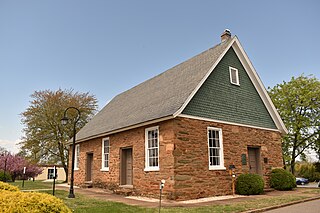
The South River Friends Meetinghouse, or Quaker Meeting House, is a historic Friends meeting house located at Lynchburg, Virginia. It was completed in 1798. It is a rubble stone structure, approximately 30 by 51 feet, with walls 16 inches thick, and 12 feet high. The building was abandoned in the 1840s, with the Quakers of the region moving to Ohio due to economic hardship and their moral opposition to slavery. The ruins of the building were utilized during the beginning of the Battle of Lynchburg, with Union troops camping near the ruins.

St. John's Church, also known as Chuckatuck Church is a historic Episcopal church located near Chuckatuck. Constructed in 1755, St. John's is the third church to occupy the site in a parish which was established in 1642. St. John's Church preserves an important role in the religious history of seventeenth century Virginia and as an architectural example of the evolving preferences of the Episcopal Church in the nineteenth century.

St. John's Church is a historic Episcopal church located near Sweet Hall, King William County, Virginia, United States. It was constructed in 1734 and is a one-story, T-shaped brick building. It measures 50 feet, 3 inches, by 20 feet, 2 inches, with a 24 feet wide, 28 feet, 9 inch, wing. St. John's is the only surviving colonial church in King William County to remain in the Episcopal charge. This church is also important in that it is associated with Carter Braxton, Signer of the Declaration of Independence, who regularly attended worship there.

Huguenot Memorial Chapel and Monument is a historic church located at Manakin, Powhatan County, Virginia. Built in 1700 by French Huguenots, Protestant refugees, it was moved to its current location in 1710. It burned down in the Revolutionary War and was later rebuilt with parts of the original building. It is in what is called the Carpenter Gothic style. A new church was built next to this in 1954, and is the one still currently used.

Mt. Olive Methodist Episcopal Church is a historic Methodist Episcopal church building in Leesburg, Virginia, United States. It was built in 1890 and is a one-story, wood-frame building in the Late Gothic Revival style. It sits on a fieldstone foundation and measures 23 feet wide and 42 feet deep.

Fork Church is a historic Episcopal church located near Ashland, Hanover County, Virginia. It was built in 1736, and is a one-story, gable roofed brick building. It measures approximately 34 feet by 74 feet and has walls 22 inches thick. The front facade features a small pedimented porch supported on square brick columns, both probably added in the early-19th century. Also on the property is a contributing church cemetery. Among the more-notable persons who often attended services at Fork Church were Patrick Henry, Dolley Madison, and the novelist Thomas Nelson Page. From 1893 to 1903, Fork Church's rector was the Reverend S. S. Hepburn, grandfather of actress Katharine Hepburn.

Hickory Neck Church is a historic Episcopal church located just outside Toano, James City County, Virginia. The original section was built between 1733 and 1738, with an extension made to the main body of the church in 1773–1774. It was altered about 1825. It is a one-story, three bay deep, rectangular brick structure, measuring 36 feet, 6 inches, long by 28 feet, 6 inches, wide.
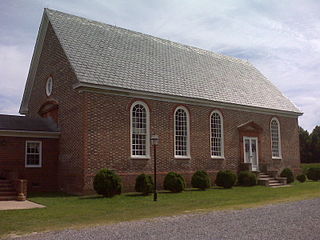
Upper Church, Stratton Major Parish is a historic Episcopal church located near Shanghai, King and Queen County, Virginia. It was built between about 1724 and 1729, and is a one-story, rectangular, brick structure, measuring 33 feet, 9 inches, long by 64 feet. The church is topped by a steeply pitched gable roof with a box cornice and cornice returns. The church was restored after a fire gutted the interior in the 1840s. The church has been used by Baptists and later Methodists since the early-19th century.
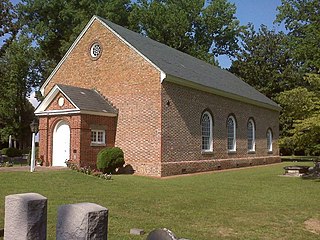
Christ Church is a historic Episcopal church located at Saluda, Middlesex County, Virginia. The present building was constructed in the 1720s, and is a one-story, rectangular brick building with a gable roof. It measures 60 feet by 33 feet, 6 inches.

Lower Church is a historic Episcopal church located near Hartfield, Middlesex County, Virginia. It was constructed in 1717, and is a one-story, rectangular brick building with a clipped gable roof. It measures 56 feet by 34 feet.
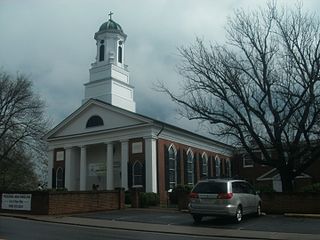
St. Thomas Church is a historic Episcopal church located at Orange, Virginia, United States. It is a rectangular brick structure measuring 40 feet wide and 105 feet deep. The front facade features a recessed portico with two Doric columns flanked by two Doric pilasters. Atop the gable roof is a three-stage tower topped by an octagonal cupola. The original church building was built in 1833–1834, and measured approximately 40 feet wide and 65 feet deep. It was built by William B. Philips, a master mason employed by Thomas Jefferson during the construction of the University of Virginia. It was enlarged and improved in 1853, and enlarged again in 1912. In 1928, the rear addition was raised to a full two stories and a parish hall constructed. The original church is believed to have been based on the plans by Thomas Jefferson for Christ Church in Charlottesville, Virginia. That church was demolished in 1895.

St. Luke's Episcopal Church is a historic Episcopal church in Fine Creek Mills, Virginia, United States. It was built in 1843–1844, and is a one-story, Classical Revival style brick church building. It measures 20 feet wide by 36 feet deep, and features a pedimented front gable roof.

St. Paul's Episcopal Church is a historic Episcopal church in Haymarket, Virginia, United States. It was started in 1801 and is a two-story, gable-roofed brick church building. The building originally served as the district courthouse for Fairfax, Fauquier, Loudon, and Prince William counties. It later housed Hygeia Academy. It was consecrated as a church in 1834, and remodeled in 1867, after being gutted during the American Civil War. The remodeling added the frame chancel, bracketed cornice, and octagonal belfry and spire.
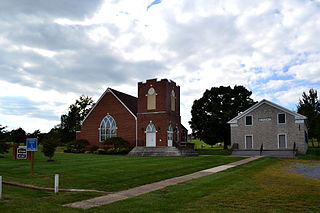
Bethlehem Church, also known as Bethlehem United Church of Christ, is a historic United Church of Christ church located at Broadway, Rockingham County, Virginia. It was built in 1844–1845, and is a small, one-story, gable-roofed limestone structure. It measures 42 feet, 6 inches, by 32 feet, 6 inches. The original vaulted ceiling and gable roof were destroyed during the American Civil War. The present gable roof was built in 1914. It was used as the primary church until a new church was constructed in 1952.
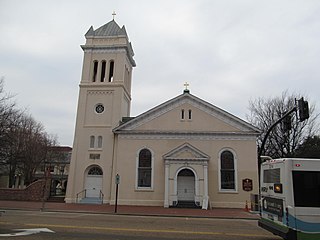
Trinity Episcopal Church is a historic Episcopal church located in Portsmouth, Virginia. It was built between 1828 and 1830, and is a stuccoed brick building. It has an attached bell tower. Also on the property is the contributing parish house, built in 1887. During the American Civil War, the church was used as a hospital.
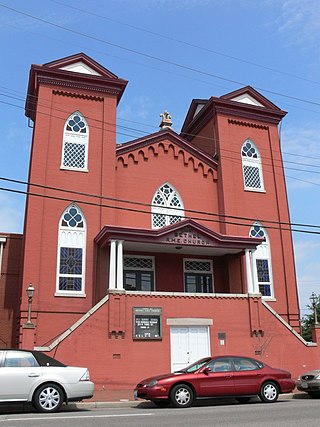
Third Street Bethel A.M.E. Church is a historic African Methodist Episcopal church located in Richmond, Virginia. It built in 1857, and remodeled in 1875. It is a large Victorian Gothic brick building with two-story towers flanking a central gable. The central gable and towers feature Gothic lancet windows.

St. Andrew's Church is an historic Episcopal church complex in Richmond, Virginia, United States. The complex consists of the church (1901), school (1901), parish hall (1904), Instructive Nurse Association Building (1904), and William Byrd Community House or Arents Free Library (1908). The church is a rough-faced Virginia granite, cruciform Gothic Revival style structure dominated by a 115-foot corner tower. The school and parish hall are three-story, brick buildings on a stone basements.

The Brookland Park Historic District is a national historic district located at Richmond, Virginia. The district encompasses 1,157 contributing buildings located north of downtown Richmond and Barton Heights.
























